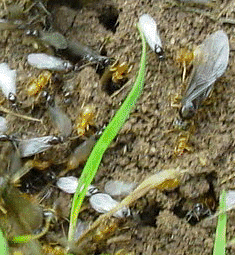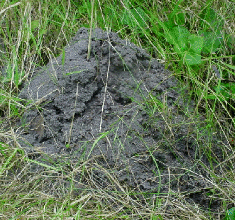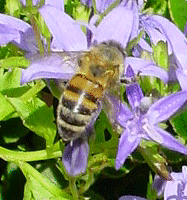
Consulting Entomologist

Tel/Fax: 01275 854224
E-Mail: [email protected]
Site Guide
Site Search
Home Page
Career Page
Insect Files
- Contents
- Bug Index
- The World of Bugs
- Classification of Bugs
- Insect Identification
- Insect Fossils
- Insect Body-parts
- Micro View of Bugs
- Insect Life Cycles
- Insect Defences
- Insects of Nailsea
- Pesticide Safety
- Bibliography
Shortcut to the main groups of insects and other arthropods...
Bug Rhymes & Poems
Links
Shop
Payments (credit/debit card)
Order Hymenoptera - Sawflies, Wasps, Ants & Bees(Hymeno-ptera, from Greek humen = membrane, pteron = wing) |
Class: Insecta Order: Hymenoptera | |
| Examples: | ||
|
Minute to moderate-sized insects, usually with two pairs of membranous wings, the front pair much larger than the hind pair. The wings are coupled together by a row of small hooks on the front edge of the hindwing. At first sight many flies (Diptera) may be confused with hymenopterans, but the flies have only one pair of wings and are easily distinguished on close examination. Eyes usually large. Antennae somewhat variable, but generally thread-like and often thickened towards the apex. Mouthparts of the biting type, many species with powerful jaws, sometimes combined with a tongue-like structure for lapping up sweet liquids. The latter is particularly well developed in the nectar-feeding bees. A well developed ovipositor at the tip of the abdomen is usually present in the female. The ovipositor is used for drilling into plant or animal tissues during egg-laying or it is modified as a sting and no longer used for laying eggs. There is a complex metamorphosis, with several larval stages and a pupal stage. Hymenopterous larvae are of two distinct types: (a) caterpillar-like, with well developed head and legs, and living on plant foliage; (b) grub-like, usually with a reduced head and always legless, and living as parasites, wood-borers, or protected in some kind of nest (see below). The pupal stage is usually enclosed in some sort of cocoon, although this may be so flimsy as to appear absent. The Hymenoptera is perhaps second only to the Coleoptera (Beetles) in terms of numbers of species. It contains over 120,000 described species and no doubt many more are yet to be discovered. Over 6,500 species occur in the British Isles. |
|
Caterpillar-like larva, typical of most Sawflies (suborder Symphyta - see below) |
Grub-like larva, typical of most Wasps, Ants and Bees (suborder Apocrita - see below) |
|
The Order is split into two well-defined suborders. These are the SYMPHYTA, in which the thorax and abdomen of the adult insect are joined across their full width without a distinct constriction between the two, and the APOCRITA, in which the abdomen of the adult is attached to the thorax by a narrow 'waist' formed by the first one or two abdominal segments. The Symphyta contains the Sawflies and Wood Wasps (or Horntails), which are the most primitive members of the order; the Apocrita contains the remaining Wasps, Ants and Bees, many of which are highly advanced and specialised insects. Only in this latter group and among the termites (Isoptera), do we find true social behaviour. From an economic standpoint, the Hymenoptera confer many benefits to our lives. Bees are important pollinators of fruit trees and other flowering plants, while the Honeybee is extensively cultured for its yield of honey and wax. A great many species are parasites of other insects and play a vital role in maintaining the balance of nature; their activities are a recognised feature in the biological control of many insect crop-pests. Among the less desirable members of the Order are the defoliating larvae of Sawflies and the wood-boring larvae of certain Solitary Wasps and Bees. Of lesser importance are the small plant-feeding larvae of some Gall Wasps, which induce unusual plant growth resulting in gall formations, such as the familiar marble galls on oak trees (known as 'oak-apples') and the bright red bedeguar galls on wild roses (often called 'robin's pincushion'). |
|
| |
| Horntail or Wood Wasp - Urocerus gigas | |
|
Description. Female 40-60 mm long, body colour black and yellow. Male slightly smaller and lacking the ovipositor or 'tail' of the female, and also the black band on the abdomen. Biology. Mainly in and around coniferous woodland. The female uses her stout ovipositor to drill into pines and other conifers (usually selecting unhealthy trees) in order to lay her eggs. The legless larvae or grubs spend their time tunnelling and feeding in the timber. Larval development may take several years and larvae can survive even after trees have been felled and cut to make floorboards and rafters. Adults emerging from cut timber sometimes cause great alarm when they appear in or around new houses and other buildings. The 'tail' of the female is often mistaken for a sting, but the insects cannot sting and are quite harmless. Distribution. British Isles and most of Europe. Photo: S. Nicholson © <<< TOP |
|
|
| |
| Pine Sawfly - Diprion (= Lophyrus) pini | |
|
Description. Female 10-12 mm long, male slightly smaller. Both sexes mainly black or dark brown, with yellow legs. Some yellow banding on the female abdomen. Antennae serrated in the female, more plumose and feather-like in the male. Larva caterpillar-like, up to 25 mm long, light yellowish-green, with black spots scattered over the body and pale brown head. Biology. A common and often serious pest in pine forests. The caterpillars live gregariously, defoliating the young shoots of conifers. One generation a year, often with a partial second brood. Distribution. British Isles and most of Europe. Illustration: adapted from Gillanders 1912 (Forest Entomology) <<< TOP |
|
|
| |
| Common Wasp - Vespula vulgaris | |
|
Description. Typical social wasp with male, female and worker castes, all with conspicuous black and yellow banding. Male 20-25 mm long, with longer antennae than the other castes and lacking a sting. Female (queen) about 25-30 mm long; workers smaller, around 15-20 mm long. One of several very similar black and yellow species. Biology. Nests under the ground or in roof cavities, building a spherical, slightly cone-shaped nest from wood pulp chewed into a greyish or yellowish paper-like material. The nest is usually suspend by a short stalk from the ceiling of the nest cavity and has an entrance hole at the bottom (see illustration - more nest images). Nests may reach football-size during the course of a season and contain up to 5,000 or more worker wasps together with the founding queen. Wasp colonies are annual affairs and die-out each year, leaving only the young mated queens, produced at the end of summer, to hibernate overwinter and start new colonies again in the following spring. Adult wasps feed mainly on nectar and other sweet liquids, but they rear their grubs on insects which the adults capture and paralyze with their sting. The immobilized prey is carried back to the nest and fed to the young stages. This predatory activity is largely beneficial, since many of the insects killed by wasps are harmful crop and garden pests, such as caterpillars and plant-feeding beetle larvae. Distribution. A common species in the British Isles and throughout most of Europe. Photo (nest): P. McDowell © <<< TOP |
|
|
| |
| Yellow Garden Ant - Lasius flavus | |
|
Description. Social insects with male, female (queen) and worker castes. Male and female winged and brownish-black, but the female sheds its wings soon after mating. Worker is wingless and yellowish-brown. Male and worker up to 7 mm long, female larger. Also called the Yellow Mound Ant. Biology. Found in all kinds of open habitats, especially grassland, and including gardens. They nest underground, often forming a large mound or hill of excavated soil. All nest building, foraging for food, care of eggs and grubs, etc., is done by the workers. The grubs are reared on a variety animal matter, mainly small insects and mites. Winged males and females are produced at certain times of the year and go off on their nuptial (or marriage) flights. This emergence is controlled by climatic conditions, so that all the nests in one area tend to produce males and females at the same time. The males die soon after mating, but the females (young queens) shed their wings and seek suitable nesting sites to start new colonies. A young queen feeds the first batch of grubs on her own saliva, but as soon as these first young workers become adult they take over the building and running of the colony, leaving the queen to devote herself to egg-laying. Garden Ants have powerful jaws and can bite if disturbed or attacked. They can also defend themselves from attackers by secreting formic acid. Nest building activity can sometimes cause disturbance and damage to plant roots, and nest mounds may interfere with mowing of garden lawns. Distribution. One of our commonest ants, found throughout the British Isles and in many parts of Europe.
<<< TOP |
|
|
RELATED PAGES (Other Hymenoptera) | |||
| BUMBLEBEES |
SOLITARY BEES & CARPENTER BEES |
SOCIAL WASPS & HORNETS |
VELVET ANTS |
|
INSECTS OF NAILSEA |
GENERAL INSECT GALLERY |
||
|
(classification of insects) |
(identification key to insect orders) |
| <<< TOP | (use the back button on your web browser to return to the previous page) | TOP >>> |


